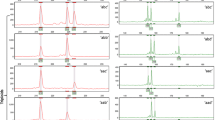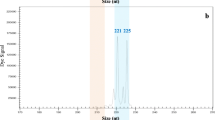Abstract
Main conclusion
Natural 2n female gametes and transmission of parental heterozygosity by natural 2n gametes in Populus tomentosa are reported for the first time, which provides a new approach to polyploid breeding.
Abstract
Naturally occurring 2n pollen is widespread in Populus tomentosa and plays an important role in polyploid breeding. However, the competitiveness of 2n pollen is lower than that of haploid pollen during pollination and fertilization, so 2n pollen is less efficient at fertilizing haploid female gametes to produce polyploids. In theory, polyploids can also be obtained when 2n female gametes are fertilized by haploid pollen. Thus, the question becomes whether natural 2n female gametes exist in P. tomentosa, which can be answered by examining the genetic composition of natural 2n gametes. In this study, the origin of 87 triploids from the hybrid combination “X-2 × Z-5” was identified by SSR markers and 21% of natural 2n gametes were found to originate from female parents. Four SSR loci with low recombination rates were used to identify the genetic composition of natural 2n gametes. The results showed that the genetic composition of 2n female gametes was mainly characterized by SDR, while 2n male gametes were mainly produced by FDR. Moreover, the transmission of parental heterozygosity by natural 2n gametes, which is significantly different between female and male parents in FDR and SDR types, was analysed using 42 SSR primers. Here, we report naturally occurring 2n female gametes for the first time in P. tomentosa and reveal the genetic constitution and transmitted parental heterozygosity of these gametes. Our results provide a foundation for theoretical research into 2n gametes and their application in new polyploid breeding strategies.





Similar content being viewed by others
Abbreviations
- SDR:
-
Second division restitution
- FDR:
-
First division restitution
- hDNA:
-
Heteroduplex DNA
- K–S:
-
Kolmogorov–Smirnov
- HR:
-
Homologous recombination
- CO:
-
Crossing-over
References
Bai FY (2015) Evaluation of elite tree resource and construction of parent population for breeding program in Populus tomentosa Carr. Dissertation, Beijing Forestry University (in chinese)
Barone A, Gebhardt C, Frusciante L (1995) Heterozygosity in 2n gametes of potato evaluated by RFLP markers. Theor Appl Genet 91:98–104
Bingham E (1980) Maximizing heterozygosity in autopolyploids. Polyploidy. Springer, pp 471–489
Bradshaw HD, Stettler RF (1993) Molecular genetics of growth and development in Populus. I. Triploidy in hybrid poplars. Theor Appl Genet 86:301–307
Chen C, Lyon MT, O’Malley D, Federici CT, Gmitter J, Grosser JW, Chaparro JX, Roose ML, Gmitter FG Jr (2008) Origin and frequency of 2n gametes in Citrus sinensis × Poncirus trifoliata and their reciprocal crosses. Plant Sci 174:1–8
De SN, Geelen D (2013) Sexual polyploidization in plants–cytological mechanisms and molecular regulation. New Phytol 198:670–684
Dong C-B, Suo Y-J, Kang X-Y (2014a) Assessment of the genetic composition of triploid hybrid Populus using SSR markers with low recombination frequencies. Can J For Res 44:692–699
Dong CB, Mao JF, Suo YJ, Shi L, Wang J, Zhang PD, Kang XY (2014b) A strategy for characterization of persistent heteroduplex DNA in higher plants. Plant J 80:282–291
Dong CB, Suo YJ, Wang J, Kang XY (2015) Analysis of transmission of heterozygosity by 2n gametes in Populus (Salicaceae). Tree Genet Genomes 11(1):799
Every AD, Wiens D (1971) Triploidy in Utah Aspen. Madroño 21:138–147
Ferrante SP, Lucretti S, Reale S, De Patrizio A, Abbate L, Tusa N, Scarano M-T (2009) Assessment of the origin of new citrus tetraploid hybrids (2n = 4x) by means of SSR markers and PCR based dosage effects. Euphytica 173:223–233
Galbraith DW, Harkins KR, Maddox JM, Ayres NM, Sharma DP, Firoozabady E (1983) Rapid flow cytometric analysis of the cell cycle in intact plant tissues. Science (New York, NY) 220:1049–1051
Harlan JR, Dewet JMJ (1975) On Ö. Winge and a Prayer: the origins of polyploidy. Bot Rev 41:361–390
Hermsen JGT (1984) Mechanisms and genetic implications of 2n gamete formation. Iowa State J Res 58:421–434
Honsho C, Sakata A, Tanaka H, Ishimura S, Tetsumura T (2016) Single-pollen genotyping to estimate mode of unreduced pollen formation in Citrus tamurana cv. Nishiuchi Konatsu. Plant Reprod 29:189–197
Hulce D, Li X, Snyderleiby T, Johathan Liu CS (2011) GeneMarker® genotyping software: tools to increase the statistical power of DNA fragment analysis. J Biomol Tech 22:S35–S36
Kang XY (1996) Chromosome count and shape of poplar. J Gansu Agric Univ 31(1):25–29 (in chinese)
Kang XY (2002a) Mechanism of 2n pollen occurring in Chinese white poplar. J Beijing For Univ 24(5/6):67–70 (in chinese)
Kang XY (2002b) Cytogenetics and selection of triploids of Populus tomentosa. China Environmental Sciences Press, Beijing (in chinese)
Kang XY, Zhu Z T, Zhang ZY (1997)Study on natural triploid of Populus tomentosa and its origin. In: The fourth annual meeting of forest genetics and breeding. Guilin, Guangxi, China, p2 (in chinese)
Liesebach H, Ulrich K, Ewald D (2014) FDR and SDR processes in meiosis and diploid gamete formation in poplars (Populus L.) detected by centromere-associated microsatellite markers. Tree Genet Genomes 11:1–10
Loureiro J, Rodriguez E, Dolezel J, Santos C (2007) Two new nuclear isolation buffers for plant DNA flow cytometry: a test with 37 species. Ann Bot 100:875–888
Masterson J (1994) Stomatal size in fossil plants: evidence for polyploidy in majority of angiosperms. Science 264:421–424
Mendiburu AO, Peloquin SJ (1977) Bilateral sexual polyploidization in potatoes. Euphytica 26:573–583
Müntzing A (1936) The Chromosomes of a Giant Populus Tremula. Hereditas 21:383–393
Nilsson-Ehle H (1936) Über Eine in der Natur Gefundene Gigasform von Populus Tremula. Hereditas 21
Peloquin SJ, Boiteux LS, Simon PW, Jansky SH (2008) A chromosome-specific estimate of transmission of heterozygosity by 2n gametes in potato. J Hered 99:177
Schuelke M (2000) An economic method for the fluorescent labeling of PCR fragments. Nat Biotechnol 18:233–234
Seitz F (1954) The occurrence of triploids after self-pollination of anomalous androgynous flowers of a grey poplar. Zeitschrift für Forstgenetik und Forstpflanzenzüchtung 3:1–6
Tamm IA, Iarvekiul’G LI (1975) Results of searches for triploid aspen in the Estonian SSR. Lesovedenie 29
Vanbuijtenen JP, Einspahr PN, Einspahr DW (1958) Naturally ocurring triploid Quaking Aspen [Populus tremuloides] in the United States. Int J Eng Educ 23:735–740
Veilleux R (1985) Diploid and polyploid gametes in crop plants: mechanisms of formation and utilization in plant breeding. Plant Breed Rev 3:253–288
Vining KJ, Pomraning KR, Wilhelm LJ, Priest HD, Pellegrini M, Mockler TC, Freitag M, Strauss SH (2012) Dynamic DNA cytosine methylation in the Populus trichocarpa genome: tissue-level variation and relationship to gene expression. BMC Genom 13:27
Vorsa N, Rowland LJ (1997) Estimation of 2n megagametophyte heterozygosity in a diploid blueberry (Vaccinium darrowi Camp) clone using RAPDs. J Hered 88:423–426
Zhang ZH, Kang XY (2006) Advances in researches on genetic markers of 2n gametes. Hereditas 28(1):105–109 (in chinese)
Zhang ZY, Li FL (1992) Studies on chromosome doubling and triploid breeding of white poplar(I): the techniques of the pollen chromosome doubling. J Beijing For Univ S3:52–58 (in chinese)
Zhang ZH, Kang XY, Zhang PD, Li YH, Wang J (2007) Incidence and molecular markers of 2n pollen in Populus tomentosa Carr. Euphytica 154:145–152
Zhang JF, Wei ZZ, Li D, Li B (2009) Using SSR markers to study the mechanism of 2n pollen formation in Populus × euramericana (Dode) Guinier and P. × popularis. Ann For Sci 66:506
Zhu ZT, Lin HB, Kang XY (1995) Studies on allotriploid breeding of Populus tomentosa B301 clones. Scientia Silvae Sinicae 31:499–505 (in chinese)
Zhu ZT, Kang XY, Zhang ZY (1998) Studies on selection of natural triploids of Populus tomentosa. Scientia Silvae Sinicae 34(4):24–33 (in chinese)
Acknowledgements
The authors would like to thank the staff of Guanxian nursery in Shandong Province, China for providing the experimental field. We are also grateful to the anonymous reviewers and editors for their constructive comments. This work was supported by National Natural Science Foundation of China (31530012).
Author information
Authors and Affiliations
Corresponding author
Rights and permissions
About this article
Cite this article
Han, Z., Geng, X., Du, K. et al. Analysis of genetic composition and transmitted parental heterozygosity of natural 2n gametes in Populus tomentosa based on SSR markers. Planta 247, 1407–1421 (2018). https://doi.org/10.1007/s00425-018-2871-4
Received:
Accepted:
Published:
Issue Date:
DOI: https://doi.org/10.1007/s00425-018-2871-4




